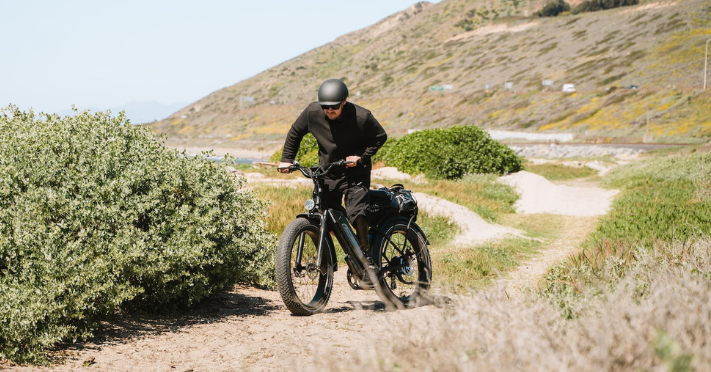Whether navigating city streets or tackling challenging off-road terrains, a crucial factor can elevate your e-biking experience to new heights: tuning your suspension with surgical precision.
In this comprehensive guide, we’ll cover all aspects of e-bike suspension, from understanding its intricacies to mastering the art of fine-tuning.
Ready for a more smooth, controlled, and comfortable ride? Let’s get into it.
Understanding E-Bike Suspension
When it comes to e-bike suspension systems, there are three primary options: front suspension, rear suspension, and full suspension. Each of these systems is tailored to specific riding preferences and terrains. Let’s take a look:
Front Suspension Forks
Front suspension is the most common and fundamental type of suspension system found in e-bikes. This system is at the front of the bike, often in the form of a fork. The typical front suspension fork consists of two sturdy struts that connect your e-bike’s front wheel to the head tube of the frame.
The key component within the fork is the internal spring mechanism, which can be either a coil or an air spring. This spring system is designed to absorb shocks and impacts generated by the front wheel as it encounters bumps, rocks, and irregularities in the terrain. The result is a smoother and more comfortable ride.
The lower part of the fork, known as sliders or lowers, connects the fork to the front wheel and the brakes. These parts connect the bumpy terrain’s impacts to the spring inside the fork.
Front suspension excels in everyday riding scenarios, making it ideal for commuting, leisurely rides, and well-maintained trails. It effectively absorbs the everyday bumps and road imperfections.
Rear Suspension
As the name suggests, rear suspension, often referred to as the rear shock, is positioned at the rear of the e-bike. This system typically relies on a coil spring, although air springs can also be found on some models.
The job of the rear suspension is to absorb impacts and shocks generated by the rear wheel. This absorption not only enhances rider comfort but also improves tire-ground contact, giving better control and reducing rider fatigue.
For riders who primarily stick to paved roads and well-maintained trails, front suspension alone is usually sufficient. However, those looking to explore unpaved or uneven terrains will find rear suspension highly valuable.
Full Suspension
Full suspension, also known as dual suspension, is the pinnacle of e-bike suspension. This configuration combines both front and rear suspension elements into a single system. It offers the utmost in riding comfort and control, making it the preferred choice for serious off-road enthusiasts, particularly mountain e-bike (eMTB) riders.
A full-suspension e-bike provides a plush and comfortable ride, effectively smoothing out even the roughest and most challenging terrains.
It’s important to note that full-suspension e-bikes tend to come with a higher price tag, both for the initial purchase and ongoing maintenance, and they are usually heavier due to the added components.
How Suspension Works
Let’s demystify how e-bike suspension systems operate:
Picture the suspension as a shock absorber for your bike. When you ride over rough terrain or encounter bumps, your bike’s wheels generate a jolt of energy. This energy travels through the wheels and into the suspension system.
The spring, whether a coil or air-filled, acts like a sponge, soaking up this jolt to keep your ride smoother. It compresses when hit with force, absorbing the shock.
But here’s the key: We don’t want the suspension to bounce uncontrollably like a pogo stick. That’s where the damper comes in. It’s like a cushion filled with oil. As the spring compresses, the damper slows it down, spreading out that shock and preventing your bike from bouncing all over the place.
Once the spring has done its job, the damper lets it rebound and extend fully, ready for the next bump. This dynamic duo of spring and damper ensures your ride remains comfortable and controlled, regardless of terrain.
Importance of Proper Suspension Adjustment
When your suspension is finely tuned, it translates to exceptional ride comfort. Bumps and rough terrain become far less jarring, allowing you to enjoy longer journeys without feeling beat up.
But it’s not just about comfort; it’s about control. With well-adjusted suspension, your e-bike handles more precisely, giving you improved stability and maneuverability, especially on those tricky trails.
Proper adjustment also extends the longevity of your bike’s components. It reduces the wear and tear caused by excessive bouncing or harsh impacts, ensuring that your e-bike remains reliable and in top-notch condition for years to come.
What is Suspension Travel?
Think of suspension travel as how much your bike’s suspension can compress.
Short-travel suspension (120mm or less) is the go-to for smooth trails, commuting, or leisurely rides because it gives you quick and responsive steering.
On the other hand, long-travel suspension (more than 120mm) is your best bet for high-speed downhill rides and rough terrains, as it prioritizes stability. Some forks even let you adjust their travel so you can fine-tune your bike to match different terrains and your personal preferences.
Understanding Sag: Your Suspension’s Sweet Spot
Sag, a crucial concept in suspension tuning, is the degree of compression your suspension undergoes under the weight of both you and your gear. Too much sag, caused by insufficient air pressure or an excessively low spring rate, can lead to bottoming out and a compromised riding experience. Imagine it like a car with weak springs; it’ll bottom out easily, resulting in a pretty uncomfortable ride.
You should aim to set your sag at around 20-30 percent of your suspension’s total travel, but the ideal percentage can vary based on your riding style. Common sag percentages for e-bike suspension tuning are as follows:
- Cross-Country (XC): Opt for lower sag, around 20 percent, to maintain efficiency and achieve higher, more upright geometry for those climbs.
- All-Mountain Adventures: Aim for approximately 25-30 percent sag. for this terrain. This strikes a balance between improved bump absorption and retaining some efficiency.
- Downhill Descents: If you’re tackling the gnarliest descents with plenty of travel in your suspension, go for around 30 percent sag. This setting maximizes traction and control while lowering your bike’s geometry for enhanced corner stability.
How To Dial In Your Suspension
Now that you know how suspension systems work, let’s get into the nitty-gritty of tuning your e-bike’s suspension for that perfect ride. Step-by-step:
1. Begin with Your Suspension Wide Open: To get things rolling, make sure your shock and fork are set to their most open setting. This sets the stage for fine-tuning your suspension.
2. Find the Recommended Pressure: Most manufacturers provide recommended pressure settings for your fork, often found on the fork itself or their official website. These numbers are your starting points for achieving the optimal sag.
3. Enter the Shock Pump: It’s time to break out your trusty shock pump. This essential tool allows you to adjust the air pressure in your suspension elements with precision. Ensure your shock and fork are pumped up to the recommended pressures.
4. Measure Sag Accurately: Most suspension components come equipped with an O-ring or markings, making it easier to measure sag. Alternatively, you can use a zip-tie temporarily, but remember to remove it before your ride to prevent any unwanted scratches that could shorten your suspension’s lifespan.
Note: Having a friend assist you can be a game-changer at this stage. They can stabilize your bike while you climb aboard and bounce lightly to help you measure sag accurately.
5. Achieving the Perfect Sag: To ensure your sag is dialed in just right, mount your bike with all the gear you’ll be carrying, including your hydration pack. Bounce lightly, then carefully dismount without compressing the suspension. Brands such as RockShox provide helpful sag measurement markings on their stanchions, while others may require you to measure from the wiper to the O-ring and divide that distance by the total stroke length to calculate your sag percentage.
Reminder: Don’t forget to keep your shock valve cap clean. This helps maintain a smoother performance, and it’s more crucial than keeping your tube valves in pristine condition.
6. Fine-tuning Your Sag: Don’t worry if your sag isn’t where you want it to be. Testing and readjustments are going to be inevitable. You can make precise adjustments by altering the spring pressure. Increasing pressure reduces sag, while decreasing it adds sag. When releasing air, use the bleeder valve on your shock pump to avoid accidentally letting too much out.
Regularly revisiting your settings is crucial to maintaining an optimal ride quality and control.
Suspension Maintenance
Regular Check-ups: Safeguarding Your Suspension
Regular check-ups for your e-bike’s suspension aren’t just an option; they’re necessary. These components are the unsung heroes of your rides, tirelessly absorbing shocks and impacts that provide you with comfort, control, and confidence on any terrain. However, like all hard-working heroes, they require care and attention to maintain their peak performance.
Here’s why those routine check-ups are essential:
- Preserving Ride Comfort: Imagine your suspension system as a cushioned barrier between you and the rough, unforgiving terrain beneath. Over time, this barrier can wear down, reducing its ability to provide a smooth and comfortable ride. Regular check-ups help you catch these signs of wear early, ensuring that your bike continues to offer the plush, bump-soaking experience it was designed for.
- Maintaining Control: Suspension isn’t just about comfort; it’s also about control. A well-maintained suspension system keeps your wheels firmly planted on the ground, allowing you to steer, brake, and accelerate with precision. Neglecting maintenance can result in unpredictable handling, jeopardizing your safety and performance on the trail.
Extending Component - Longevity: Your e-bike’s suspension components are an investment. By conducting regular check-ups, you’re extending the lifespan of these valuable assets. Identifying and addressing minor issues early can prevent them from escalating into major, costly repairs or replacements down the line.
- Proactive Problem Solving: Routine inspections aren’t just about spotting existing issues but also anticipating potential problems. Your suspension system operates in demanding conditions, exposed to mud, rocks, and the elements. These elements can lead to corrosion, damage, or compromised seals. Regular check-ups act as your first line of defense, allowing you to address these issues before they become critical.
Keep it Clean
Proper e-bike maintenance extends to cleaning. Keeping the suspension system clean will help keep any grit or debris from finding its way into the internal components and wreaking havoc like tiny gremlins!
Common E-Bike Suspension Hiccups and Solutions
Your e-bike’s suspension system is a complex marvel, but like all mechanical wonders, it can sometimes encounter hiccups. Here are some common issues you might encounter and the solutions to get your ride back on track:
1. Squeaking or Creaking
- Issue: That annoying squeak or creak can damage your ride. It often results from friction between components.
- Solution: Silence the noise by applying lubrication to the affected areas, reducing friction and restoring your peaceful ride.
2. Leaks
- Issue: If you spot telltale signs of oil or air leaks, it might signal a damaged seal or component.
- Solution: Don’t let the leaks dampen your spirits. Seek the expertise of a professional who can diagnose the issue and perform any necessary repairs or replacements.
3. Bottoming Out
- Issue: Frequent bottoming out can leave you feeling like your suspension isn’t up to the task. It’s a sign of excessive compression.
- Solution: Regain control by adjusting the preload settings or increasing the air pressure. This ensures your suspension can handle those challenging trails without feeling overwhelmed.
4. Lack of Suspension Travel
- Issue: When your suspension feels stiff or has limited travel, it can diminish your riding experience.
- Solution: Investigate the cause by checking for any obstructions hindering the suspension’s movement. You can also fine-tune your settings to increase the suspension travel, restoring the smooth, responsive ride you crave.
Final Thoughts
Whether you’re zipping through city streets or conquering rugged trails, your e-bike’s suspension can make or break the entire experience.
From front to full suspension, we’ve dissected the options, delved into the mechanics, and unveiled the tuning secrets. You now know how the spring and damper work together, why sag matters, and how to dial in your suspension for a personalized, performance-packed ride.
Armed with this knowledge, you’re ready to navigate the world of e-bike suspension like a pro. Enjoy smoother, more controlled rides, tackle terrains with confidence, and extend the life of your trusty two-wheeled companion.
The roads and trails beckon, and now, you’re more than ready to answer the call.



